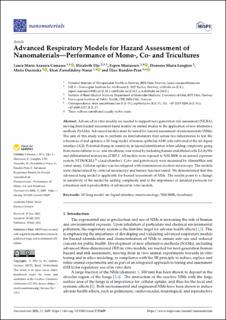| dc.contributor.author | Camassa, Laura Maria Azzurra | |
| dc.contributor.author | Elje, Elisabeth | |
| dc.contributor.author | Mariussen, Espen | |
| dc.contributor.author | Longhin, Eleonora Marta | |
| dc.contributor.author | Dusinska, Maria | |
| dc.contributor.author | Zienolddiny-Narui, Shanbeh | |
| dc.contributor.author | Rundén-Pran, Elise | |
| dc.date.accessioned | 2022-09-05T06:45:22Z | |
| dc.date.available | 2022-09-05T06:45:22Z | |
| dc.date.created | 2022-08-15T12:33:31Z | |
| dc.date.issued | 2022 | |
| dc.identifier.citation | Nanomaterials. 2022, 12, 2609. | en_US |
| dc.identifier.issn | 2079-4991 | |
| dc.identifier.uri | https://hdl.handle.net/11250/3015630 | |
| dc.description.abstract | Advanced in vitro models are needed to support next-generation risk assessment (NGRA), moving from hazard assessment based mainly on animal studies to the application of new alternative methods (NAMs). Advanced models must be tested for hazard assessment of nanomaterials (NMs). The aim of this study was to perform an interlaboratory trial across two laboratories to test the robustness of and optimize a 3D lung model of human epithelial A549 cells cultivated at the air–liquid interface (ALI). Potential change in sensitivity in hazard identification when adding complexity, going from monocultures to co- and tricultures, was tested by including human endothelial cells EA.hy926 and differentiated monocytes dTHP-1. All models were exposed to NM-300K in an aerosol exposure system (VITROCELL® cloud-chamber). Cyto- and genotoxicity were measured by AlamarBlue and comet assay. Cellular uptake was investigated with transmission electron microscopy. The models were characterized by confocal microscopy and barrier function tested. We demonstrated that this advanced lung model is applicable for hazard assessment of NMs. The results point to a change in sensitivity of the model by adding complexity and to the importance of detailed protocols for robustness and reproducibility of advanced in vitro models | en_US |
| dc.language.iso | eng | en_US |
| dc.rights | Navngivelse 4.0 Internasjonal | * |
| dc.rights.uri | http://creativecommons.org/licenses/by/4.0/deed.no | * |
| dc.title | Advanced Respiratory Models for Hazard Assessment of Nanomaterials. Performance of Mono-, Co- and Tricultures | en_US |
| dc.title.alternative | Advanced Respiratory Models for Hazard Assessment of Nanomaterials. Performance of Mono-, Co- and Tricultures | en_US |
| dc.type | Peer reviewed | en_US |
| dc.type | Journal article | en_US |
| dc.description.version | publishedVersion | en_US |
| dc.rights.holder | © 2022 by the authors. Licensee MDPI, Basel, Switzerland. | en_US |
| dc.source.pagenumber | 26 | en_US |
| dc.source.volume | 12 | en_US |
| dc.source.journal | Nanomaterials | en_US |
| dc.source.issue | 15 | en_US |
| dc.identifier.doi | 10.3390/nano12152609 | |
| dc.identifier.cristin | 2043008 | |
| dc.relation.project | EC/H2020/952404 | en_US |
| dc.relation.project | EC/H2020/8144259 | en_US |
| dc.relation.project | Norges forskningsråd: 272412 | en_US |
| dc.relation.project | Norges forskningsråd: 288768 | en_US |
| dc.source.articlenumber | 2609 | en_US |
| cristin.ispublished | true | |
| cristin.fulltext | original | |
| cristin.qualitycode | 1 | |

